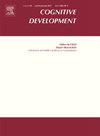在缺乏意图信息的情况下,幼儿对违法者的怀疑是有利的
IF 1.8
3区 心理学
Q3 PSYCHOLOGY, DEVELOPMENTAL
引用次数: 0
摘要
幼儿在他们的规范性判断中考虑违法者的意图。但是,在不知道违规者意图的情况下,孩子们如何评价道德违规者呢?在三项研究中,5岁的讲德语的儿童(N = 216,108名女孩,108名男孩)观察到消极的道德结果,违法者要么微笑(快乐条件),震惊(惊讶条件),要么没有表情,因为他们的脸完全空白(无表情条件)。然后,孩子们成对地(研究1和2)或独立地(研究3)对每次违规的故意结构进行推理。在研究1中,二人组得出结论,在快乐条件下,违规行为是故意的,在惊讶条件下,违规行为是偶然的,在无表情条件下,违规行为是偶然的。在研究2和3中,方法上的改变意味着孩子们在没有表情的情况下得出错误是偶然的结论,而在快乐的情况下则是偶然的。当意图信息无法获得时,5岁的孩子更倾向于将积极的意图归咎于没有任何表达的违规者,并给予他们怀疑的好处。本文章由计算机程序翻译,如有差异,请以英文原文为准。
Young children give transgressors the benefit of the doubt in the absence of intention information
Young children consider transgressors’ intentions in their normative judgments. But how do children evaluate moral transgressions in the absence of information about a transgressor’s intent? Across three studies, 5-year-old German-speaking children (N = 216, 108 girls, 108 boys) observed negative moral outcomes in which the transgressor was either smiling (happy condition), shocked (surprised condition) or was without expression, in that their face was left entirely blank (no-expression condition). Children then reasoned in pairs (Study 1 and 2) or independently (Study 3) about the intentional structure of each transgression. In Study 1, dyads concluded the transgressions were intentional in the happy condition, accidental in the surprised condition, and were at-chance in the no-expression condition. In Studies 2 and 3, methodological changes meant children concluded the transgressions were accidental in the no-expression condition and were at-chance in the happy condition. When intention information was thus unavailable, 5-year-olds preferred to ascribe positive intentions to transgressors devoid of all expression and give them the benefit of the doubt.
求助全文
通过发布文献求助,成功后即可免费获取论文全文。
去求助
来源期刊

Cognitive Development
Multiple-
CiteScore
3.20
自引率
5.60%
发文量
114
期刊介绍:
Cognitive Development contains the very best empirical and theoretical work on the development of perception, memory, language, concepts, thinking, problem solving, metacognition, and social cognition. Criteria for acceptance of articles will be: significance of the work to issues of current interest, substance of the argument, and clarity of expression. For purposes of publication in Cognitive Development, moral and social development will be considered part of cognitive development when they are related to the development of knowledge or thought processes.
 求助内容:
求助内容: 应助结果提醒方式:
应助结果提醒方式:


